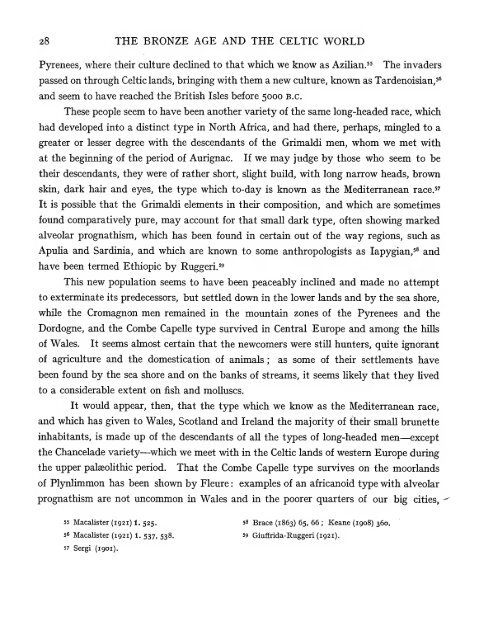The bronze age and the Celtic world - Universal History Library
The bronze age and the Celtic world - Universal History Library
The bronze age and the Celtic world - Universal History Library
You also want an ePaper? Increase the reach of your titles
YUMPU automatically turns print PDFs into web optimized ePapers that Google loves.
28 THE BRONZE AGE AND THE CELTIC WORLD<br />
Pyrenees, where <strong>the</strong>ir culture declined to that which we know as Azihan." <strong>The</strong> invaders<br />
passed on through <strong>Celtic</strong> l<strong>and</strong>s, bringing with <strong>the</strong>m a new culture, known as Tardenoisian,'*<br />
<strong>and</strong> seem to have reached <strong>the</strong> British Isles before 5000 B.C.<br />
<strong>The</strong>se people seem to have been ano<strong>the</strong>r variety of <strong>the</strong> same long-headed race, which<br />
had developed into a distinct type in North Africa, <strong>and</strong> had <strong>the</strong>re, perhaps, mingled to a<br />
greater or lesser degree with <strong>the</strong> descendants of <strong>the</strong> Grimaldi men, whom we met with<br />
at <strong>the</strong> beginning of <strong>the</strong> period of Aurignac. If we may judge by those who seem to be<br />
<strong>the</strong>ir descendants, <strong>the</strong>y were of ra<strong>the</strong>r short, slight build, with long narrow heads, brown<br />
skin, dark hair <strong>and</strong> eyes, <strong>the</strong> type which to-day is known as <strong>the</strong> Mediterranean race.^'<br />
It is possible that <strong>the</strong> Grimaldi elements in <strong>the</strong>ir composition, <strong>and</strong> which are sometimes<br />
found comparatively pure, may account for that small dark type, often showing marked<br />
alveolar prognathism, which has been found in certain out of <strong>the</strong> way regions, such as<br />
Apuha <strong>and</strong> Sardinia, <strong>and</strong> which are known to some anthropologists as lapygian,'^ <strong>and</strong><br />
have been termed Ethiopic by Ruggeri.'^<br />
This new population seems to have been peaceably inclined <strong>and</strong> made no attempt<br />
to exterminate its predecessors, but settled down in <strong>the</strong> lower l<strong>and</strong>s <strong>and</strong> by <strong>the</strong> sea shore,<br />
while <strong>the</strong> Cromagnon men remained in <strong>the</strong> mountain zones of <strong>the</strong> Pyrenees <strong>and</strong> <strong>the</strong><br />
Dordogne, <strong>and</strong> <strong>the</strong> Combe Capelle type survived in Central Europe <strong>and</strong> among <strong>the</strong> hills<br />
of Wales. It seems almost certain that <strong>the</strong> newcomers were still hunters, quite ignorant<br />
of agriculture <strong>and</strong> <strong>the</strong> domestication of animals ; as some of <strong>the</strong>ir settlements have<br />
been found by <strong>the</strong> sea shore <strong>and</strong> on <strong>the</strong> banks of streams, it seems likely that <strong>the</strong>y lived<br />
to a considerable extent on fish <strong>and</strong> moUuscs.<br />
It would appear, <strong>the</strong>n, that <strong>the</strong> t5^e which we know as <strong>the</strong> Mediterranean racCi<br />
<strong>and</strong> which has given to Wales, Scotl<strong>and</strong> <strong>and</strong> Irel<strong>and</strong> <strong>the</strong> majority of <strong>the</strong>ir small brunette<br />
inhabitants, is made up of <strong>the</strong> descendants of all <strong>the</strong> types of long-headed men—except<br />
<strong>the</strong> Chancelade variety— ^which we meet with in <strong>the</strong> <strong>Celtic</strong> l<strong>and</strong>s of western Europe during<br />
<strong>the</strong> upper palaeolithic period. That <strong>the</strong> Combe Capelle type survives on <strong>the</strong> moorl<strong>and</strong>s<br />
of Plynlimmon has been shown by Fleure : examples of an africanoid type with alveolar<br />
prognathism are not uncommon in Wales <strong>and</strong> in <strong>the</strong> poorer quarters of our big cities, -<br />
55 Macalister (1921) 1, 525. 58 Brace (1863) 65, 66 ; Keane (1908) 360.<br />
56 Macalister (1921) 1. 537, 538. 59 Giufirida-Ruggeri (1921).<br />
57 Sergi (1901).







